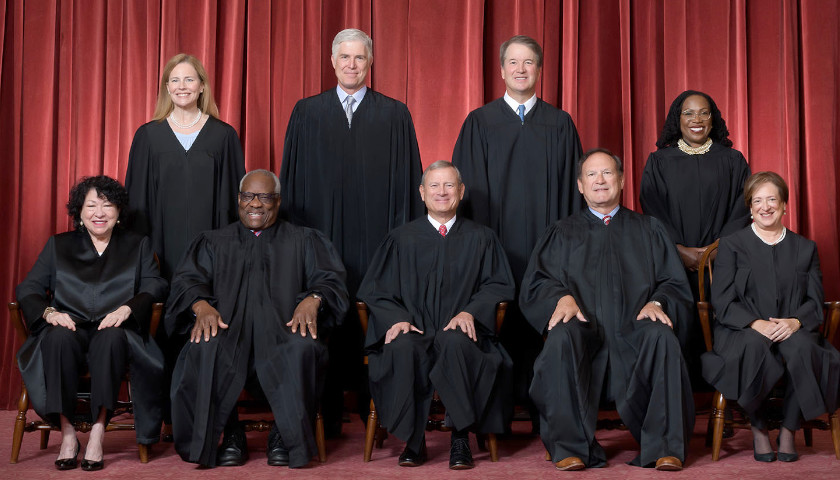by Hans von Spakovsky
Chief Justice John Roberts made a major error in judgment last week in rejecting the State of Alabama’s 2022 congressional redistricting plan in Allen v. Milligan, an error that, as dissenting Justice Samuel Alito says, puts the Voting Rights Act “on a perilous and unfortunate path.”
Joined by the three liberal justices and Justice Brett Kavanaugh, Roberts, writing for the majority, approved race being the driving factor in drawing up the boundary lines of political districts, while glibly denying he was doing that. That violates Section 2 of the Voting Rights Act and the U.S. Constitution.
Alabama has seven congressional districts. Since 1992, one of those districts, District 1, has been a majority/minority district where black voters can elect their candidate of choice. That plan was drawn by another federal court in 1992 as a result of another lawsuit filed under the Voting Rights Act.
 District 1, as dissenting Justice Clarence Thomas says, occupies the “southwest pocket of Alabama, consisting of the State’s two populous Gulf Coast counties,” including the port of Mobile. It is “indisputable” that this Gulf Coast region is the “sort of community of interest” around which the state legislature could decide a congressional district should be built since it contains the state’s only coastline, its only port, is bordered on the north by the Alabama and Mobile Rivers, and its economy “is tied to the Gulf – to shipping, shipbuilding, tourism and commercial fishing.”
District 1, as dissenting Justice Clarence Thomas says, occupies the “southwest pocket of Alabama, consisting of the State’s two populous Gulf Coast counties,” including the port of Mobile. It is “indisputable” that this Gulf Coast region is the “sort of community of interest” around which the state legislature could decide a congressional district should be built since it contains the state’s only coastline, its only port, is bordered on the north by the Alabama and Mobile Rivers, and its economy “is tied to the Gulf – to shipping, shipbuilding, tourism and commercial fishing.”
Since 1992, Alabama legislators have maintained District 1 with only marginal changes in the boundary lines. In that entire time, there has been virtually no change in the black population of Alabama, which was then, and remains today, about a quarter of the state’s population.
But the NAACP and other liberal groups challenged the 2022 congressional map. They claimed that black voters were entitled to two majority/minority districts and that the failure to provide a second black district violated Section 2 of the Voting Rights Act, which prohibits “the denial or abridgment of the right to vote of any citizen” based on his or her race or color.
A three-judge panel found in the challengers’ favor and issued an injunction prohibiting use of the plan. Yet the only way that the NAACP’s experts could fashion a second black district was to break up District 1 and make race the predominant factor in drawing the new boundary lines. There was virtually no evidence in the case that Alabama legislators had somehow denied or abridged the right of black Alabamians to vote, despite Robert’s claims to the contrary.
Instead, as Thomas pointed out, the only real basis for the lower court’s decision concluding that the redistricting plan diluted black residents’ votes was because “it is possible to draw two majority black districts” in the state (emphasis in original). But, said Thomas, the “text of § 2 and the logic of vote-dilution claims require a meaningfully race-neutral benchmark, and no race-neutral benchmark can justify” the lower court’s finding of vote dilution.
In fact, says Thomas, the “only benchmark that can justify it,” and the one the lower court applied, “is the decidedly nonneutral benchmark of proportional allocation of political power based on race.” In other words, because blacks constitute about a quarter of Alabama’s population, the lower court concluded they are entitled to two of the seven congressional seats.
But the Voting Rights Act specifically states that it doesn’t establish “a right to have members of a protected class elected in numbers equal to their proportion of the population.” Yet, that is exactly what the lower court did, and what the Supreme Court has now approved.
Moreover, the Supreme Court’s prior precedents have held that using race as the predominant factor in redistricting to separate voters into different districts based on race, is an “odious” practice prohibited by the Equal Protection Clause of the Fourteenth Amendment.
Thomas castigated the majority for approving a “consciously segregated districting system” that violates the “color-blind” requirements of the Constitution. He was joined by three other justices, including Samuel Alito, who wrote in a separate dissent that the “conspicuous violations of traditional districting criteria” by the challengers, criteria such as compactness and contiguousness, “constitute strong circumstantial evidence of unconstitutionality” (emphasis in original). And it is “direct evidence of illegality” when, as here, “it is shown that the configuration of a district is attributable predominantly to race” (emphasis in original).
Alito said that the majority’s opinion actually violates the Voting Rights Act, the Court’s prior precedents, and “the fundamental principle that States are almost always prohibited from basing decisions on race.”
This terrible decision will encourage lawmakers to ignore traditional, non-racial, neutral redistricting rules and instead draw political district boundary lines based on race. In other words, it will encourage discrimination in the political arena on the patronizingly racist assumption that our race defines our politics.
– – –
Hans A. von Spakovsky is a Senior Legal Fellow and Manager of the Election Law Reform Initiative at the Heritage Foundation and a former Justice Department lawyer and FEC commissioner. He is the coauthor of “Our Broken Elections: How the Left Changed the Way You Vote.”
The views and opinions expressed in this commentary are those of the author and do not reflect the official position of the Daily Caller News Foundation.
Photo “Justices” by Supreme Court of the United States.








